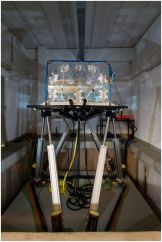Sloshing Laboratory

Dr.-Ing. Jens Neugebauer Duisburg Sloshing Laboratory (6DOF Device)
In the Sloshing Laboratory, the motions of a ship are simulated. A plastic tank mounted on top of the motion device represents a cargo tank of the ship. For technical reasons, cargo tanks for liquids are never filled up completely. Sloshing occurs if, due to tank motions, liquid cargo is induced to “move” as well. The grade of excitation is dependent on the tank motions as well as of its frequency spectrum. Typically, spectra are used which correspond to those in natural seaways.
During operation, even in moderate seaways, tanks may be exposed to high sloshing-induced loads. In the laboratory the loads on the tank are measured and analysed, focusing on the cargo containment systems used onboard liquefied natural gas carriers (LNG).
With the Sloshing Laboratory, amongst others, examinations are carried out concerning the sloshing-induced loads on LNG tanks onboard ships. These are designed for the transport of natural gas at a temperature of around - 162°C. Other types of tanks, swimming-pools on cruise ships or vehicle tanks may also be the object of laboratory examinations. Moreover, the laboratory is used for tests assisting validation and extension of numerical methods.
Components of the device
The laboratory consists of several individual systems which are configured, depending on the tasks of a test series:
- The Stewart-Platform, also known as Hexapod, is the centrepiece of the laboratory. By that, model tanks of a total mass of up to 1,200 kgs can be moved in 6 Degrees of Freedom. Additionally, the Hexapod has an integral system for position measurements.
- In contrast to the large original vessel tanks, the model tanks consist of thick-walled acrylic glass, making it easy to observe the liquid behaviour. Each tank has a large number of sensor fields which can be equipped with sensors for pressure measurements.
- If necessary, pressure sensors and wave sensors can be installed in sensor modules mounted on the tanks in order that the development of pressures and the movement of the water surface can be observed.
- A data acquisition system supplies different sensor types and can record all measurement channels simultaneously at a rate of up to 100k Samples/s/ch.
- Two high-speed cameras can record the tank or fluid motions.
- By a stereo Particle-Image-Velocimetry (PIV) System, non-intrusive measurements of the flow velocities within a laser illuminated light sheet in the liquid phase are possible.
The tests are carried out in model scale. Gas and liquid phases are represented by air and water at ambient temperature and transferred to full-scale and natural gas by means of model laws. Depending on the type of test, the test period ranges from seconds to several hours. The laboratory is automated to a high degree so that measurement campaigns can be run over several weeks.
Sponsoring
The purchase of the Sloshing Laboratory was sponsored by the Federal State of NRW and the DFG within the scope of a research proposal for large equipment.

